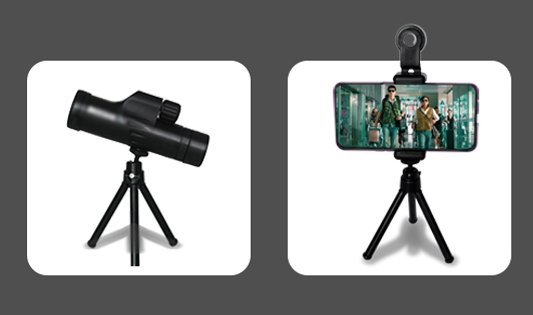What optic is being used?
As far as stabilization goes, a well-made tripod, will hold any standard field binocular or spotting scope firmly in place for long-duration viewing.
Full-size spotting scopes—those with objective diameters of 60mm and larger—with magnification levels beginning at 15x-20x or more, benefit from the stability a tripod’s three legs on the ground provide. Larger diameter binoculars.
Standard (40mm to 56mm objective) and mid-size binoculars (30mm to 35mm objective). However, their smaller size also makes them very suitable for attaching to a monopod to increase their versatility in the field. Smaller spotting scopes (50mm to 56mm objective).
Where is this optic being used?
Tripods offer superb stability as well as the ability to be used hands-free; however, to provide these handy features, they take up a fair bit of ground or floor space. If the binocular or spotting scope is being used in the wide-open spaces of the great outdoors, this isn’t generally a problem. Yet even out in the field, there are still things to consider that may limit the amount of space available to set up a tripod—trail width, for example, as well as surface, slope, and the number of people nearby.
This last is especially important to consider if the viewing location is a platform or hide. Viewing platforms, while frequently spacious, are often erected in scenic locations. Consequently, there may be a larger number of people, some of whom may not be familiar with “tripod courtesy” coming and going. Viewing hides, being enclosed, are often quite small and cozy, with narrow viewing portals that are best used with the optic positioned as close as possible to them—something fully extended tripod legs may not allow.
For what purpose is the optic being used?
For digiscoping through a full-size spotting scope, a tripod is preferred for its stability and ease of hands-free use. This, of course, is not to say that a monopod cannot be used for this purpose.
If the spotting scope is to be carried by one of a number of people in the field together—a trip leader, teacher, or parent, for example—a tripod is essential to allow the optic to be focused on a subject and multiple viewers to take turns seeing it or for a NexYZ to be attached and the image shown to all at once via the screen of the smartphone.
For hiking or other activities where keeping the gear load as light as practically allowable, a monopod is a right choice for its smaller size and low weight; they can be used as handy hiking poles as well. Monopods are also quite useful in providing a bit of additional steadiness for older users for whom hand tremors might be a challenge, as well as in astronomical observing with lower magnification binoculars

